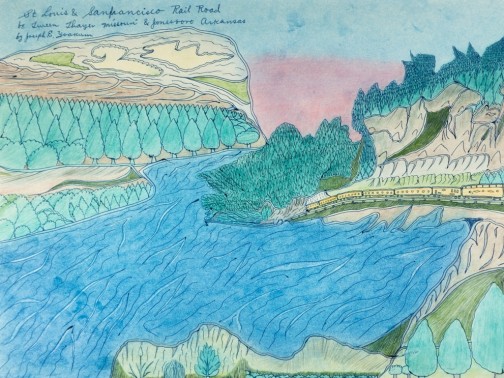
Installation view of Joseph Elmer Yoakum, Venus Over Manhattan, New York, 2019
Installation view of Joseph Elmer Yoakum, Venus Over Manhattan, New York, 2019
Installation view of Joseph Elmer Yoakum, Venus Over Manhattan, New York, 2019
Installation view of Joseph Elmer Yoakum, Venus Over Manhattan, New York, 2019
Installation view of Joseph Elmer Yoakum, Venus Over Manhattan, New York, 2019
Installation view of Joseph Elmer Yoakum, Venus Over Manhattan, New York, 2019
Installation view of Joseph Elmer Yoakum, Venus Over Manhattan, New York, 2019
Installation view of Joseph Elmer Yoakum, Venus Over Manhattan, New York, 2019
Installation view of Joseph Elmer Yoakum, Venus Over Manhattan, New York, 2019
Installation view of Joseph Elmer Yoakum, Venus Over Manhattan, New York, 2019
Installation view of Joseph Elmer Yoakum, Venus Over Manhattan, New York, 2019
Installation view of Joseph Elmer Yoakum, Venus Over Manhattan, New York, 2019
Installation view of Joseph Elmer Yoakum, Venus Over Manhattan, New York, 2019
Installation view of Joseph Elmer Yoakum, Venus Over Manhattan, New York, 2019
Installation view of Joseph Elmer Yoakum, Venus Over Manhattan, New York, 2019
Installation view of Joseph Elmer Yoakum, Venus Over Manhattan, New York, 2019
Installation view of Joseph Elmer Yoakum, Venus Over Manhattan, New York, 2019
Installation view of Joseph Elmer Yoakum, Venus Over Manhattan, New York, 2019
Installation view of Joseph Elmer Yoakum, Venus Over Manhattan, New York, 2019
Installation view of Joseph Elmer Yoakum, Venus Over Manhattan, New York, 2019
Installation view of Joseph Elmer Yoakum, Venus Over Manhattan, New York, 2019
Installation view of Joseph Elmer Yoakum, Venus Over Manhattan, New York, 2019
Installation view of Joseph Elmer Yoakum, Venus Over Manhattan, New York, 2019
Installation view of Joseph Elmer Yoakum, Venus Over Manhattan, New York, 2019
Installation view of Joseph Elmer Yoakum, Venus Over Manhattan, New York, 2019
Installation view of Joseph Elmer Yoakum, Venus Over Manhattan, New York, 2019
Installation view of Joseph Elmer Yoakum, Venus Over Manhattan, New York, 2019
Installation view of Joseph Elmer Yoakum, Venus Over Manhattan, New York, 2019
Installation view of Joseph Elmer Yoakum, Venus Over Manhattan, New York, 2019
Installation view of Joseph Elmer Yoakum, Venus Over Manhattan, New York, 2019
Installation view of Joseph Elmer Yoakum, Venus Over Manhattan, New York, 2019
Installation view of Joseph Elmer Yoakum, Venus Over Manhattan, New York, 2019
Installation view of Joseph Elmer Yoakum, Venus Over Manhattan, New York, 2019
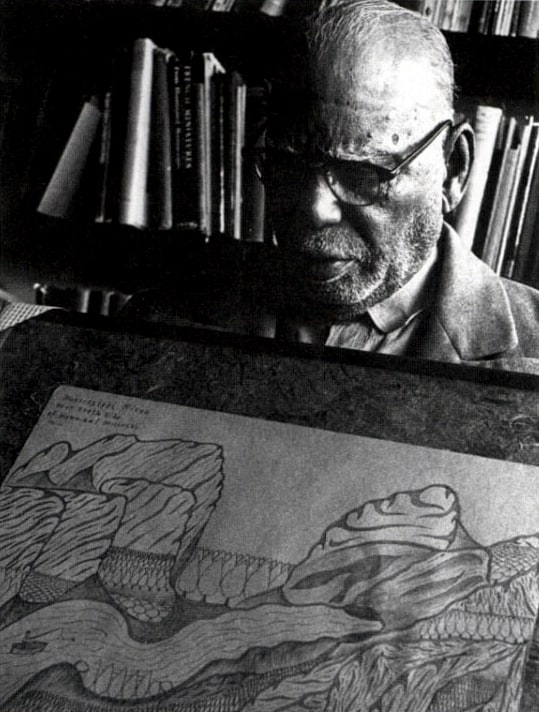
Joseph Elmer Yoakum with “Mississippi River Neir Noth Side," c. late 1960s. Archives of American Art, Smithsonian Institution, Whitney B. Halstead papers
Joseph Elmer Yoakum
June 20 – July 26, 2019
Opening: Thursday, June 20th, 6:00 - 8:00 pm
Venus Over Manhattan
980 Madison Avenue
New York, NY 10075
(New York, NY) – Venus Over Manhattan is pleased to present Joseph Elmer Yoakum, an exhibition comprising more than sixty works on paper by the visionary American artist. On the tails of his inclusion in Lynne Cooke’s “Outliers and American Vanguard Art,” the presentation marks the largest group of Yoakum’s work assembled in New York since 1972, when the Whitney Museum of American Art staged a solo exhibition dedicated to his work. In conjunction with the presentation, the gallery will publish a major catalogue featuring a new text on the artist, archival material, and contributions from the Art Institute of Chicago, the Roger Brown Study Collection at the School of the Art Institute of Chicago, Intuit: The Center for Intuitive and Outsider Art, The Museum of Everything, Jeff Koons, and KAWS. The exhibition will be on view from June 20th through July 26th, 2019.
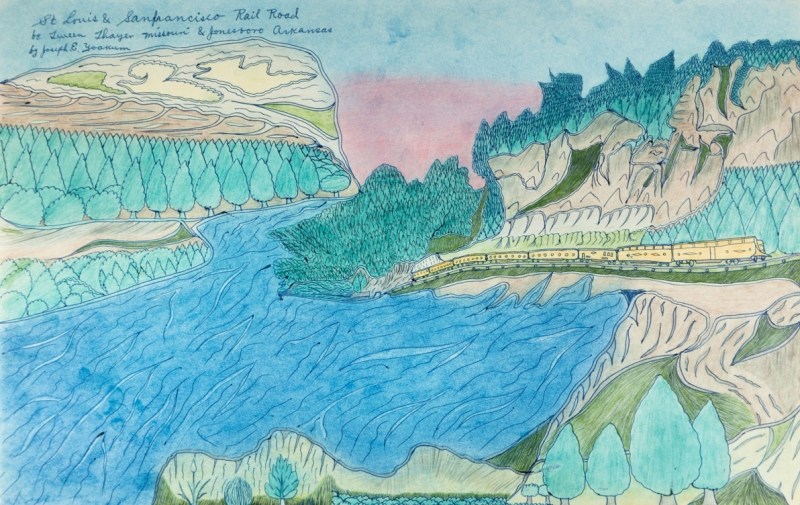
St Louis & Sanfrancisco Rail Road between Thayer Missouri & Jonesboro Arkansas, n.d.
An artist of African American and Native American descent, Joseph Elmer Yoakum made drawings that describe a life spent traveling, first with the circus as a young man, then with the army during World War I, and later, alone hopping train cars in the American West – all before settling in Chicago, where he committed to a life of art making around 1962. A set of competing narratives seeks to account for the details of his life: per official documentation, Joseph Elmer Yoakum was born to John Yokum (a previous spelling of the family name) and Frances Wadlow on February 20th, 1890, in Ash Grove, Missouri. But according to Yoakum, he was born in 1888, “near the village of Window Rock, Arizona, in the Southwest territory before it were [sic] made the Navajo and Apache Indian reservation.” He often claimed Navajo heritage, referring to himself as “Na-va-JOE,” but his Native American heritage can rather be traced to the Cherokee Nation, through both of his parents. Many aspects of his biography remains similarly uncertain – such as his time spent traveling with the Ringling Brothers Circus, or his role as a billposter for Buffalo Bill Cody’s Wild West Show – and contribute to a picture of his life that rests between myth and fact.
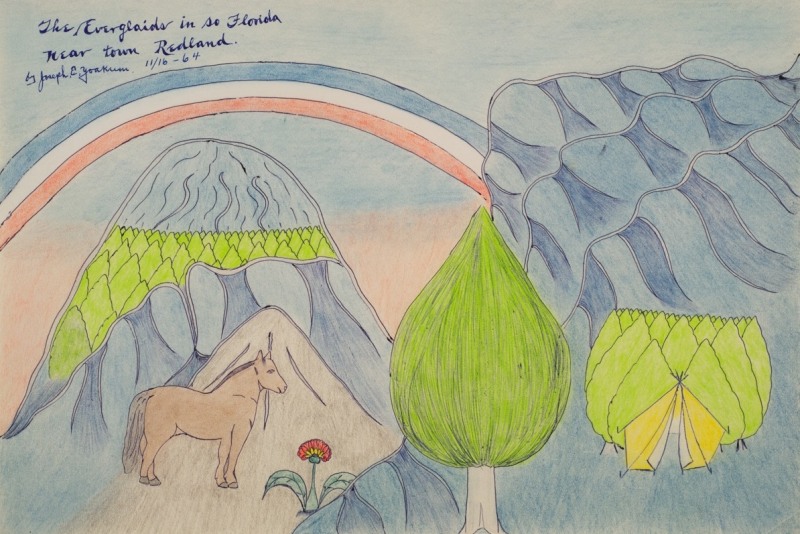
The Everglades in So. Florida near town Redland, 1964
Yoakum first settled in Chicago in the late 1920s, where he spent some thirty years working as a mechanic, carpenter, and railroad inspector, before dedicating his life to his art around 1962, at the age of 72. Yoakum relocated to a storefront on Chicago’s South Side in 1966, where he began the most productive period of his career. It was during this time that Yoakum developed his mature style: characterized by a densely patterned and radically flattened approach, Yoakum’s drawings often feature brightly colored geographies, gently moving streams, and complex layers of receding trees. Yoakum claimed to have traveled to each of the locations he drew – locations often denoted by a specific title in the top left quadrant of the page, much like a picture postcard – and that he pulled his compositions from memory. Though many expressed doubts about the truth of his claims, one of the artist’s biographers, Derrel B. DePasse, found that Yoakum had indeed visited may of the places his drawings depict.
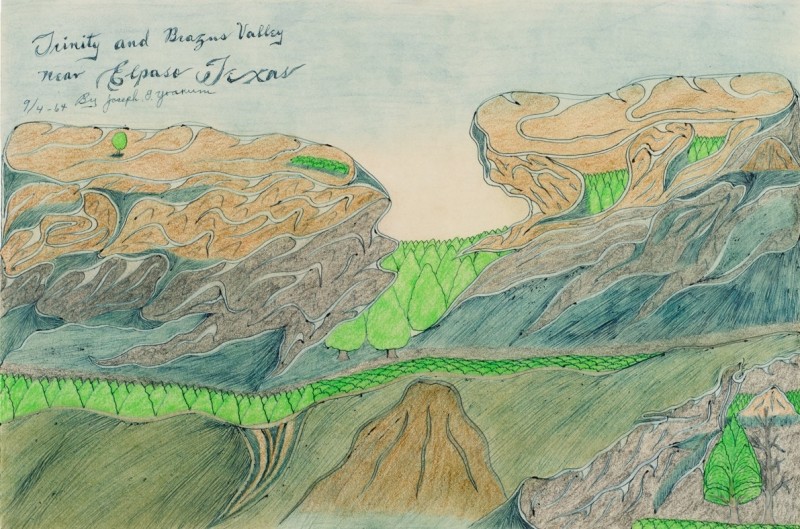
Trinity and Brazus Valley near Elpaso Texas, 1964
John Hopgood, an instructor at Chicago State College, happened upon Yoakum’s studio in 1967, and immediately recognized the quality of his work. Hopgood organized Yoakum’s first show at The Whole, a coffee shop in the basement of St. Bartholomew’s Church of Englewood, and secured him representation with the Edward Sherbeyn Gallery, which staged a second exhibition of his work in 1968. This exhibition caught the attention of Whitney Halstead, a professor at the School of the Art Institute of Chicago, who became Yoakum’s greatest champion. Halstead’s students at the time were a group of artists who came to be known as the Chicago Imagists, and included Roger Brown, Gladys Nilsson, Jim Nutt, Ed Paschke, and Christina Ramberg, many of whom championed, collected, and drew inspiration from Yoakum’s work. Indeed, as Roger Brown described, finding Yoakum “was like finding [Henri] Rousseau in our own backyard." Yoakum’s success ballooned from there, culminating in a major solo presentation at the Whitney Museum of American Art, curated by Marcia Tucker, which opened just a month before Yoakum died.
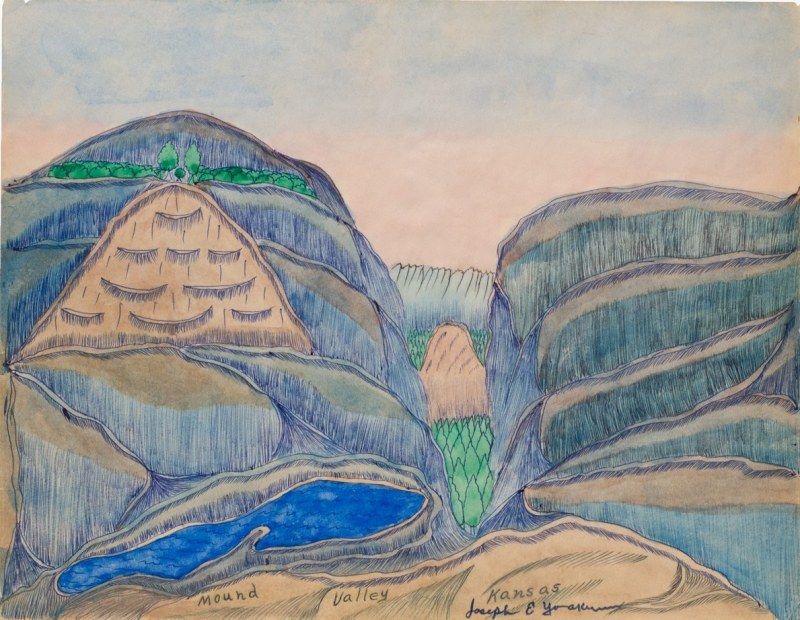
Mound Valley, Kansas, n.d.
ABOUT JOSEPH ELMER YOAKUM
Joseph Elmer Yoakum was, according to official record, born in Ash Grove, Missouri, in 1890. His work has been the subject of numerous solo presentations, including exhibitions at the David and Alfred Smart Museum of the University of Chicago; Intuit: The Center for Intuitive and Outsider Art, Chicago; the Art Institute of Chicago; and the Whitney Museum of American Art, New York. Yoakum’s work is frequently featured in major group exhibitions, including recent presentations at the National Gallery of Art, Washington, D.C.; the Carnegie Museum of Art, Pittsburgh; the Museum of Modern Art, New York; and the Philadelphia Museum of Art, Philadelphia. His work is held many public collections, including the Art Institute of Chicago; The Menil Collection, Houston; and the Museum of Modern Art, New York. Joseph Elmer Yoakum lived and worked in Chicago until his death in 1972.
For further information about the exhibition and availability, please contact the gallery at info@venusovermanhattan.com
For all press inquiries related to the exhibition, please email press@venusovermanhattan.com
Joseph Elmer Yoakum recollects his adventurous life in signature curvilinear language.
Yoakum's picaresque life and his late embrace of an artistic vocation call to mind traditional myths that assume artists are born, not made.
The visionary landscapist Joseph Elmer Yoakum (1888-1972) has been categorized as an outsider, self-taught or folk artist. Whichever: His place in the expanding canon of 20th-century American art is assured, both for his achievement and influence.
A cornucopia of over 60 exquisitely beautiful quasi-abstract colored-pencil landscapes by Native and African-American visionary Joseph Yoakum — and that look like they might have been made on Mars — is emitting undulant optical auroras at Venus Over Manhattan gallery.
These captivating ballpoint-and-watercolor landscapes are confident improvisations based on the American artist’s extensive travels.
African- and Native-American artist Joseph Elmer Yoakum, one of the best artists of the 1960s, was in his 70s when he began to make art full time.
Joseph Yoakum is an artist we should all know better.
It's another busy week for art in New York as summer officially begins.
Joseph Elmer Yoakum (1890–1972) was a self-taught African-American artist who claimed Native American ancestry. Though records show he was born in Missouri, he asserted that his birthplace was on the Navajo Reservation in Window Rock, Arizona, and repeatedly referred to himself “Na-va-JOE.” (He also said he was of African, French and Cherokee descent.)
For an even wilder walk on the wild side of landscape painting, Venus Over Manhattan gallery in New York presents Joseph Yoakum June 20 through July 26. Yoakum was a self-taught artist, his work variously categorized as “outlier,” “outsider,” “folk,” “naïve,” “vernacular.”
